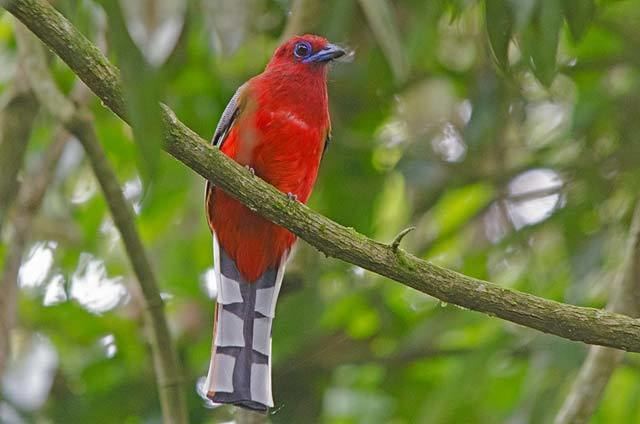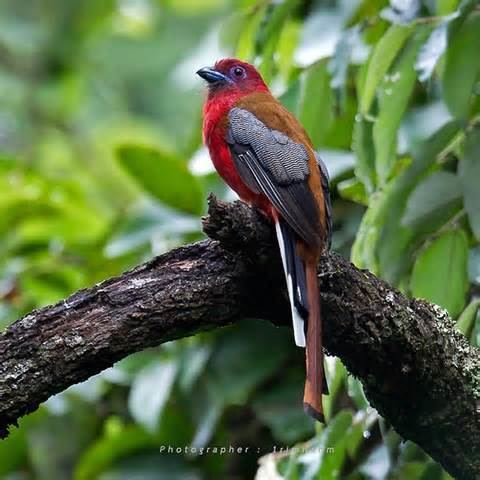Phylum Chordata Rank Species | Family Trogonidae Scientific name Harpactes erythrocephalus Higher classification Harpactes | |
Similar Trogon, Bird, Harpactes, Orange‑breasted trogon, Ward's trogon | ||
Red headed trogon
The red-headed trogon (Harpactes erythrocephalus) is a species of bird in the family Trogonidae.
Contents
- Red headed trogon
- Etymology
- Appearance
- Subspecies
- Distribution
- Habitats and Status
- Migration
- Habits
- Calls
- Feeding
- Nesting
- Eggs
- References
Red headed trogon
Etymology
H. erythrocephalus comes from the Ancient Greek terms eruthro meaning red and kephalos meaning head.
Appearance

The red-headed trogon is on average 34 cm (13 in) in length. The male has a red head and breast, a unique feature in the Trogon group. The female resembles the Diard’s trogon without a speckled undertail.
The head, neck and upper breast of an adult male is dull crimson. A narrow white band crosses the mid breast, underneath which the lower breast to abdomen is light red to pink. Pale red can be observed on the flanks whereas the mantle and back of the bird are rusty brown. The male perches on branches with the support of mauve-blue legs. Regarding wing colouration, the lesser and median wing coverts, secondary coverts, as well as outer webs of tertials and secondaries are vermiculated black and white. The primary feathers also appear black and white. As for the bird’s long tail, the central feathers are dark brown with a black tip, the second and third pairs are black and the outer pairs are white with black bases. Finally, a black-tipped cobalt blue bill, a deep mauve-blue gape and eyering and reddish-brown irises shape the bird’s face.

The head, neck and upper breast of an adult female are olive-brown. Just like the male, a narrow white band crosses the mid breast, underneath which the lower breast to abdomen is light red to pink. The mantle and back appear orange to brown in colour. The wings are vermiculated dark brown and yellowish brown. The tail feathers are very similar to those of the males. The bill, gape and bare eyering are pale blue on females.

At the juvenile stage, the head, neck and upper-parts are buff brown, whereas the underparts appear buff white. No black tip on the narrower central tail feathers can be observed.
Subspecies
Harpactes erythrocephalus erythrocephalus: nominate species as described above.
Harpactes erythrocephalus helenae: both sexes are slightly larger than H. erythrocephalus erythrocephalus. In addition, the coverts and outer webs of the tertials and secondaries are more finely vermiculated.
Harpactes erythrocephalus yamakanensis: found in Southeastern China, it is larger than H. erythrocephalus erythrocephalus. Males have a darker coloured head and neck and the white band across its breast is narrower, the abdomen paler, and the outer tail feathers darker. Females also have a darker coloured head, neck and upper body. The white band across the breast is absent.
Harpactes erythrocephalus rosa: very similar to the subspecies H. erythrocephalus yamakanensis. This bird is confined to northern Guangxi, China.
Harpactes erythrocephalus hainanus: found only on Hainan Island, China. Altogether it appears darker than H. erythrocephalus erythrocephalus.
Harpactes erythrocephalus intermedius: in this subspecies, the coverts and outer webs of the tertials and secondaries are more finely vermiculated. The male's plumage is brighter, the female’s darker, more intense. It can be found in Southern China, Northern Laos, and Northern Vietnam.
Harpactes erythrocephalus annamensis: in both sexes, the feathers are more coarsely vermiculated and the upperparts more yellowish-brown. This subspecies is distributed throughout Central and Southern Vietnam, Southern Laos, and Northeastern Thailand into Cambodia.
Harpactes erythrocephalus klossi: compared to H. erythrocephalus erythrocephalus, the head feathers appear scarlet red instead of crimson, whilst other body feathers are a paler brown. The female is all in all paler. H. erythrocephalus klossi is only found on Koh Chang Island (South-Eastern Thailand), and the Bhantat Range (on the border between Thailand and Cambodia).
Harpactes erythrocephalus chaseni: very similar to H. erythrocephalus klossi. It lives throughout the Malay Peninsula albeit sparsely.
Harpactes erythrocephalus flagrans: slightly smaller than H. erythrocephalus erythrocephalus, it is only found in Sumatra, Indonesia.
Distribution
The Red-headed trogon is a widely distributed species of the Harpactes genus and is occurs across much of the Indian subcontinent and Southeast Asia. It is sporadically distributed from North-Eastern India and Central Nepal to Southern China, through the Malay Peninsula all the way to areas of Sumatra.
Habitats and Status
The red-headed trogon prefers upland forests. In the Himalayan foothills it lives in dense broad-leaved forests and in tropical and subtropical zones the species inhabits mostly mixed bamboo forests. In Southeast Asia, this species frequents broadleaved evergreen forests from 300m up to 2600m. In Myanmar, Red-headed trogons live in bamboo and oak forests at 2500m altitude with Ward's Trogons (Harpactes wardi). On the Malay Peninsula, the birds can be observed regularly between 300m and 1680m in evergreen lowland, lower montane and taller upper montane forests. Towards the south of the peninsula however, it is rarely seen below 700m. In Laos, it shares its habitat of evergreen forests and adjacent plains 1700m high, with the Orange-breasted Trogon (Harpactes oreskios). Finally, in northern, western and southern Thailand, it favours climax broad-leaved evergreen forests between 400m and 2000m which it also shares with the Orange-breasted Trogon (Harpactes oreskios).
The bird's local conservation status varies depending on the level of disturbance in the forest. Generally speaking it is locally fairly common in Northeastern India, frequent in Bhutan, and locally dispersed in Bangladesh. The forests of Vietnam appear to be a stronghold, for the birds are reported regularly from many localities throughout the country. Elsewhere throughout its range, it is uncommon to scarce, including Nepal where habitat destruction most certainly explains a rapid decline in population numbers in that area.
Migration
In most regions, the red-headed trogon is sedentary although researchers have observed altitudinal movements in Southern Laos, as well as in the Sangthong district, Northern Laos.
Habits
Red-headed trogons can most often be found perched on a shaded branch waiting for prey, alone or in pairs. Flight between trees is often sluggish and very low, only a few meters above the ground.
Red-headed trogons are most active in the early hours of the morning and at night, when they fly on the edges of forest clearings in pursuit of flying moths.
In central south Thailand, they share their habitat with the Orange-breasted trogon (Harpactes oreskios). The two species often follow flocks of foraging birds taking advantage of the insects they flush out.
Calls
The male’s call resembles that of the Eurasian golden oriole (Oriolus oriolus): a sequence of usually five to six, well-spaced mellow “tyaup” notes, repeated every minute. Occasionally the male calls an extended “pluu-du” note marked by a significant terminal drop in pitch. The call is repeated every 3–6 seconds. As an alarm signal, the Red-headed trogon emits a chattering croak.
Feeding
Red-headed trogons feed primarily on insects and their larvae found in the foliage, on tree branches or in mid air. They also eat leaves and fruits. Some food items include green orthopterans, stick-insects, cicadas, millipedes, flies, beetles, centipedes, woodlice and moths.
Nesting
In Northern India, eggs are laid between mid April and mid July, with a peak in May and June. In China, eggs are laid in April, as do eggs in Myanmar. In Thailand, nesting occurs slightly earlier, in March and continues until July, while on the Malay Peninsula dependent juveniles have been observed anytime between early March and late May.
Red-headed trogons usually nest in natural tree cavities, 1.5 to 5m above the ground. The entrance hole is generally wide. Indeed, the pair will enlarge narrow entrances, and occasionally, will excavate the entire nesting cavity. Birds have been seen using old nesting holes of woodpeckers and barbets.
Both sexes contribute to the nesting process, namely excavating, incubating the eggs, brooding and feeding the offspring. However females spend more time brooding, since they alone incubate and brood at night. Males on the other hand contribute more to providing the chicks with food. During the day the pair will take it in turns to brood although they have been known to incubate together.
Nest success is low, at about 9%.
Eggs
Red-headed trogons lay round, cream coloured, glossy eggs. Each egg measures approximately 26.5-27.5mm x 23.5-24.0mm. The mean clutch size is 2.6 eggs (between 2 and 4), with an incubation period of 18 days and a nestling period of 13.4 days, according to a single study in Thailand.
